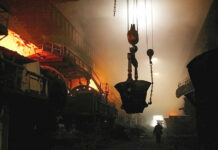
[miningmx.com] – THE unbundling of Glencore’s 23.9% stake in Lonmin saw a 5% wobble in the UK platinum miner’s shares on June 12 and came amid some observations that this was a company so devalued that it was better to buy it than build a new shaft.
Yet, it’s perhaps surprising to note that shares in Lonmin performed the best of the big four – including Anglo American Platinum (Amplats), Impala Platinum (Implats) and Northam Platinum – during the last 30 days. Shares in Lonmin are down only 10% compared to a 17% slide in the share of Amplats, followed by Implats, which is 16% lower.
Even over six months, Lonmin is not the worst performing platinum share having fallen 22% in value versus a loss of 23% for Implats. Over a year, Lonmin shares have lost 46% of their value, slighly less than the 48% shed by Implats and 41% shed by Amplats. Shares in Northam are 16% stronger over the last 12 months.
Yet the company has attracted a high degree of negative analysis, a turn of events that some analysts think is related to its lack of operational options, the inevitability of restructuring, and its reluctance – or worse, its inability – to turn to the equity or debt markets.
Lonmin’s stated strategy has been to cut costs and to protect is balance sheet. It also vowed to maintain 20 months of developed reserves at all time in order to provide it with operational flex and thrust when the upturn in metal prices arrives.
On May 7, Lonmin CEO, Ben Magara, announced plans to reduce labour costs by 10% by cutting 3,500 jobs, an announcement that Barclays analyst, Andrew Bryne said had been “no surprise” having already asked in research if it was time for change.
However, Leon Esterhuizen, an analyst at CIBC Capital Markets said the strategy would only deliver a smaller company with higher costs that would be unable to fund even its sustaining capital expenditure at current metal prices.
“In our opinion, the entire strategy is premised on just one thing: hoping the metal price increases sharply before the company faces a forced, heavily dilutive equity issue at a time when the chances of success would be badly compromised.
“As far as we are concerned, this is tantamount to playing chicken with a big truck that could lead to enormous losses for Lonmin shareholders,” he said. Esterhuizen believed Lonmin has to refinance its balance sheet.
Analysts argue that Lonmin’s asset base is weaker than its peers and may need the investment.
Whereas Amplats has a strong cash generator in Mogalakwena, and Implats also has operational flexibility, Lomin has “… very few options available to deliver a business that can survive long term at these prices,” said Marc Elliott, an analyst for Investec Securities.
“It is possible that Lonmin has shafts that could turn a profit, but the company simply doesn’t disclose the information necessary to make that assessment,” he added.
According to Goldman Sachs, Lonmin has few refinancing options and is set for inevitable restructuring. Some $560m in debt refinancing will be a push as the company is not producing any positive cash flow, it said.
It views Lonmin as South Africa’s marginal player with little optionality to remedy this. “Increasing production to lower its costs is no longer an option as the company lacks the necessary funds and is generating insufficient cash to fund its capex,” it said in a report in May.
Having iced its K4 project, the company will also struggle to cut its unit costs through volume growth, and should new low-cost capacity come online over the next two to three years, Lonmin’s mine should begin to burn cash rather than breaking even over the next 12 to 24 months, said Goldman Sachs.
Esterhuizen said that whilst he respected Lonmin’s view that metal prices must improve, he doubts the team really has this conviction or it’d be “out there making the call now and building to be ready”. He likens Lonmin’s strategic approach to “hibernating without piling on some fat”.











